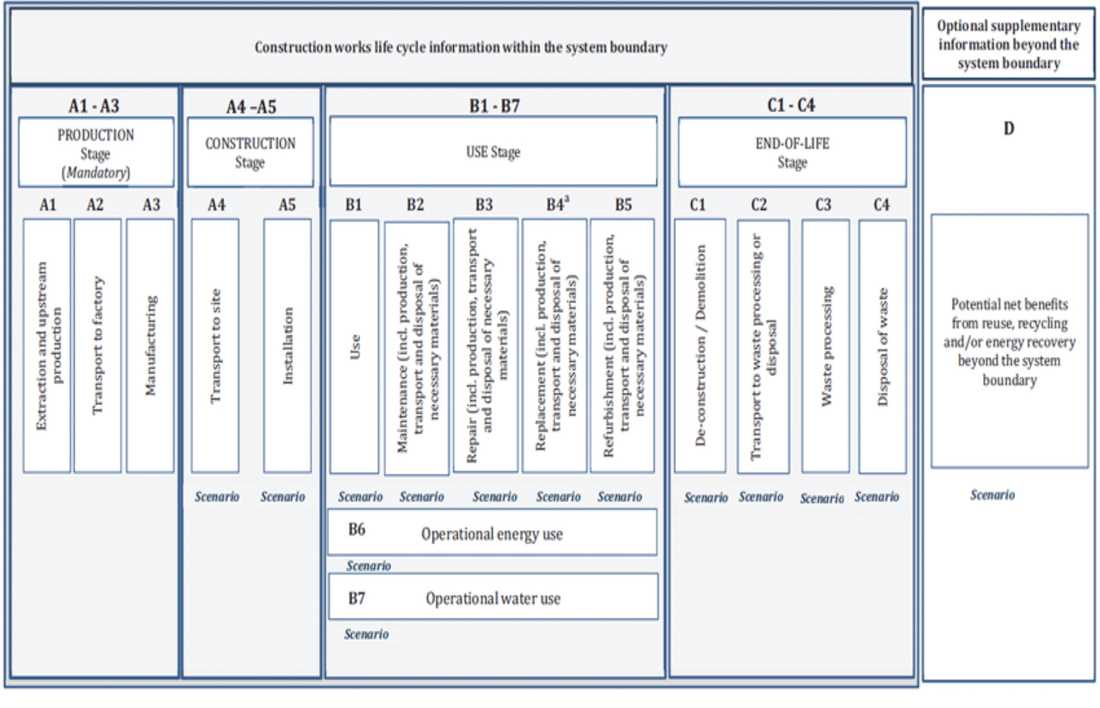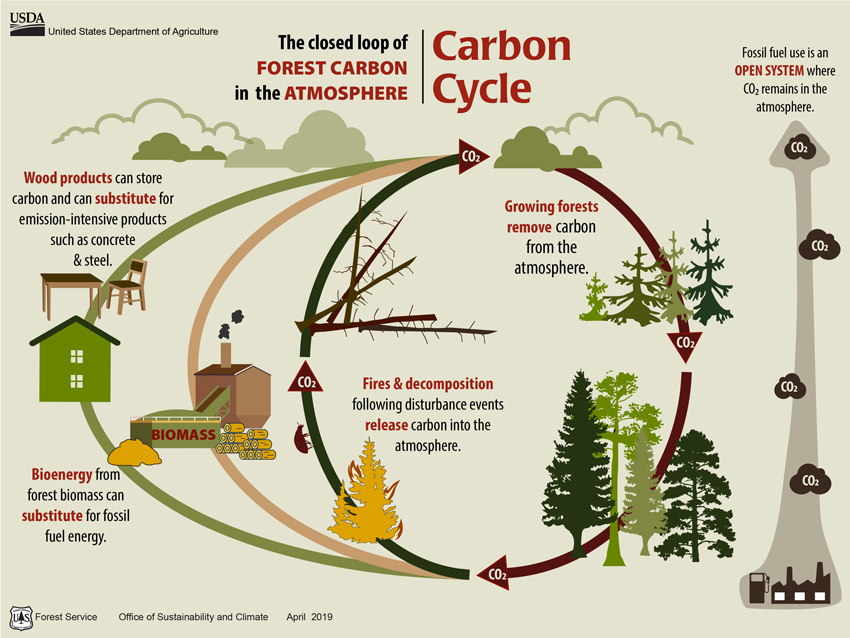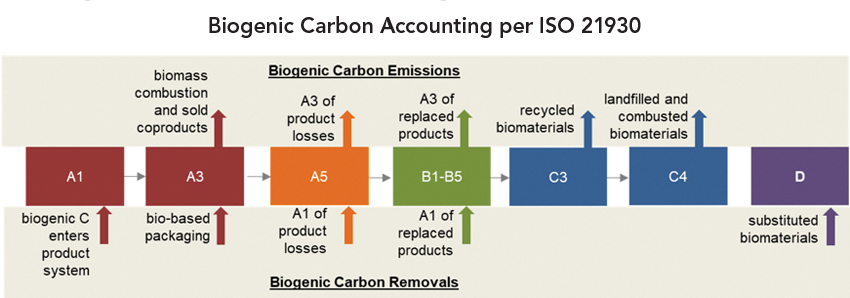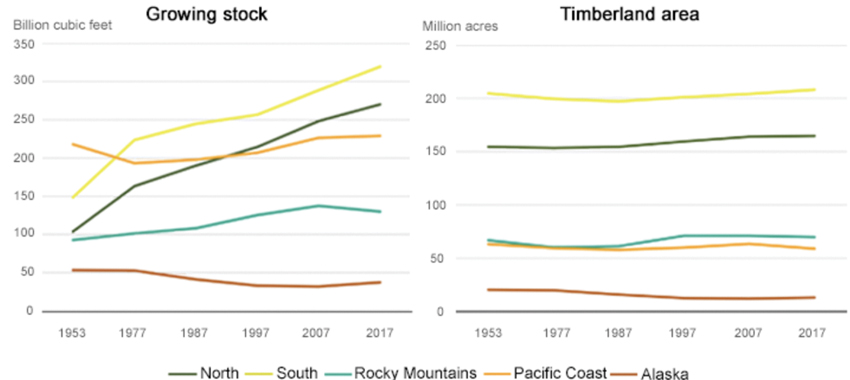How to Calculate the Wood Carbon Footprint of a Building
The Product Level: Wood Environmental Product Declarations and What They Can Tell Us
The ability to assess the environmental impact of a building ultimately rests on the life-cycle information for each component material. Sometimes consumers just want this information available at the product level.
An EPD is a standardized, third-party-verified label that communicates the environmental performance of a product. Data for an EPD is based on an LCA report, third-party verified for conformance to a specific set of product category rules (PCR). The comparison of material specific EPDs that are based on different PCRs is not readily achievable and requires considerable expertise in LCA. An EPD includes information about both product attributes and production impacts, and it provides information to industrial customers and end-use consumers regarding environmental impacts. The nature of EPDs also allows summation of environmental impacts along a product’s supply chain—a powerful feature that greatly enhances the utility of LCA-based information.
ISO 21930, the ISO standard that sets out core rules for environmental product declarations of construction products and services, separates the stages of construction into five modules: production, construction, use, end-of-life, and optional supplementary beyond the system boundary, as shown in Figure 1.

Figure 1: Building material life-cycle information (stages and modules) with the system boundary.12
Wood EPDs are underpinned by the biogenic carbon cycle—in product storage, energy for manufacturing, and impacts in the forest. A cycle, by its very nature, is not linear and not as well suited for life-cycle assessment methodology, which mathematically is a mass-balance equation underpinned by linear algebra. The complexity of the biogenic cycle warrants detailed explanation.
Difference between Biogenic and Fossil Carbon
As trees grow, they clean the air we breathe by absorbing CO2 from the atmosphere. Trees release the oxygen (O2) and incorporate the carbon (C) into their twigs, stems, roots, leaves or needles, and surrounding soil. Young, vigorously growing trees take up CO2 quickly, with the rate slowing as they reach maturity (typically 60-100 years, depending on species and environmental factors). A single tree can absorb as much as 48 pounds of CO2 per year and sequester up to 1 ton of CO2 by the time it reaches 40 years old.13 As trees mature and then die, they start to decay and slowly release the stored carbon back into the atmosphere.

Figure 2: The closed-loop cycle of forest carbon in the atmosphere versus the open/one-way system of fossil fuel.14
Carbon can also be released back to the atmosphere, but more quickly, when forests succumb to natural hazards such as wildfire, insects, or disease. Growing forests absorb, store, and release carbon over extended periods of time. This cycle is a closed-loop cycle through natural processes of growth, decay, and disturbances. It is also a closed-loop cycle when forests are harvested for use in products or energy as shown in Figure 2. The biogenic carbon cycle fundamentally differs from the open/one-way flow of fossil carbon to the atmosphere. Whether trees are harvested and used for products or decay naturally, the cycle is ongoing, as forests regenerate and young trees once again begin absorbing carbon. However, when trees are manufactured into products and used in buildings, a new phase of carbon mitigation begins and some carbon is never returned to the atmosphere.

Figure 3: Biogenic removals (inputs) and emissions (outputs) in North American Wood Product EPDs.15
Explanation of How Biogenic Carbon Is Addressed in ISO 21930 and Wood Product EPDs
North American Wood Product EPDs follow guidance from ISO 21930 to account for biogenic carbon. Section 7.2.11 requires confirmation either a) that that country of wood origin’s net carbon stocks are stable or increasing, or b) the fiber comes from a certified forest (see next section). In the EPD, biogenic carbon then enters the product system as sequestered carbon (denoted as a removal), and its emissions are tracked and reported in the stages where they occur (see Figure 3).
If the EPD is a cradle-to-gate EPD, the emissions associated with end-of-life are also included, creating a zero balance; hence the long-term carbon storage associated with the harvested wood product can only be included in a cradle-to-grave EPD. Many wood product EPDs, however, estimate the long-term storage using USFS methodology and report in the “additional information section.”
In 2020 the American Wood Council and Canadian Wood Council published updated cradle-to-gate EPDs for six of the major North American wood products (softwood lumber, plywood, OSB, laminated veneer lumber, I-joists, and glued laminated timber), replacing the 2013 versions (www.awc.org/sustainability/epd). The primary data used to develop these EPDs are based on mill surveys for each product category. These were used to develop life-cycle assessments, which is the data used to create the EPD. A 2018 Special Issue of The Forest Products Journal compiled these LCAs, which can be found on the Consortium for Research on Renewable Industrial Material (CORRIM’s) website (corrim.org/fpj-special-issue).
EPDs are best able to assess environmental impacts associated with the stages outlined above. Assessment of landscape management impacts on the other things we care about, like biodiversity, water quality, and overall sustainability, are best captured through complementary assurances, such as sustainable forestry certification.
Other Forest Sustainability Assurances
Forest Certification
Forest certification assesses a landowner’s forest management against a series of agreed standards related to water quality, biodiversity, wildlife, and forests with exceptional conservation value. Wood is one of the few building materials that has third-party certification programs in place to demonstrate that products being sold have come from a responsibly managed resource. As of 2020, more than 600 million acres of forest in the United States and Canada were certified under one of the four internationally recognized programs used in North America.17 About 47 percent of forests in Canada are certified and 19 percent in the United States, both above the global average of 11 percent.18
The four primary systems in North America, Sustainable Forestry Initiative (SFI), Forest Stewardship Council (FSC), Canadian Standards Association (CSA), and American Tree Farm System (ATFS), all have slightly different principles and procedures. SFI is a single-standard North American program. FSC is a global program with regional standards. CSA is the Canadian National Forest Management Standard, and ATFS is geared toward smaller U.S. landowners.
Given the cost of third-party verification, wide-scale certification is not feasible for the small family landowners that make up the largest percentage of land ownership in the United States (almost 290 million acres). U.S. federal timberlands are not certified, but this does not mean they are not being sustainably managed. In 2007, the Pinchot Institute conducted a study of five national forests and found their management practices met many of the certification requirements in terms of forest planning, protection of threatened and endangered species, and others.19
Another type of certification aimed at the mills, fiber sourcing certification, focuses on assurances that can be made in the supply chain. There are three major responsible fiber sourcing standards in North America (see sidebar on previous page).
In addition, every U.S. state has developed best management practices (BMPs) guidelines for water quality and other environmental concerns such as soil erosion and regeneration. Some of these are codified into state forest practice regulation and others are voluntary. Water quality BMPs, whether regulatory, quasi-regulatory, or non-regulatory, are tracked in the United States and achieve above 90 percent compliance in all states.20 This is important because roughly 60 percent of drinking water is sourced from forests across the nation, up to 75 percent in the U.S. West.21

Figure 4: Forest Inventory (billion cubic feet) by region 1953–2017 as well as acres of timberland.









